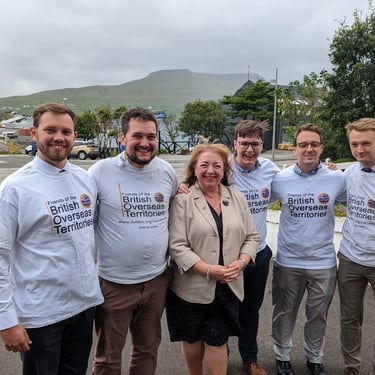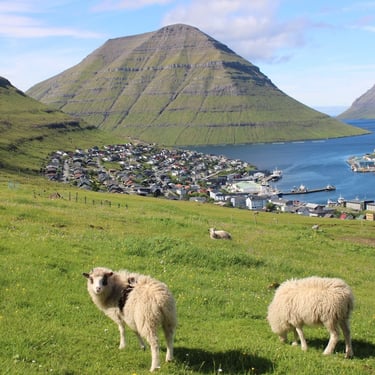FOTBOT visit to the Faroe Islands
Earlier this month members of the FOTBOT committee, along with Sharon Hodgson MP, visited the Faroe Islands - an autonomous country within the Kingdom of Denmark, located in the North Atlantic.
NEWS FROM FOTBOT
Earlier this month members of the FOTBOT committee, along with Sharon Hodgson MP, visited the Faroe Islands - an autonomous country within the Kingdom of Denmark, located in the North Atlantic.
The charity was invited by the Faroese government with the purpose of learning more about the constitutional relationship between the Faroe Islands and Denmark. We are currently in the process of writing a report of our findings, comparing the Faroe Islands’ constitutional situation to the various arrangements in place between the UK and the British Overseas Territories.
The FOTBOT party arrived in the Faroe Islands on Thursday 7th July, taking time to explore the capital city Tórshavn.
Friday 8th July began with an invitation to the Danish High Commissioner’s office where the FOTBOT delegation met the High Commissioner’s chief advisor Elsa Maria L. Østergaard. This was a particularly insightful meeting, learning how the Danish High Commissioner differs from a British Governor as well as learning about the difference between the status of Greenland and the Faroe Islands within the Danish Realm.
The next meeting was at the parliament of the Faroe Islands – The Løgting – which claims to be the oldest parliament in the world. Here we met with members of the Faroese parliament, learning about the powers which have been devolved from Denmark as well as the increasing military interest in the territory, due to the recent rise in tensions with Russia and NATO. With the Faroe Islands’ location in the UK-Iceland-Greenland gap, the territory has the potential to be of great strategic value to the North Atlantic alliance, in order to monitor Russian Warships passing through the area.
Following the meeting with local parliamentarians, the charity was invited to the Foreign Service building in the government district of Tingenes. Here we met with the head of the Faroese foreign service Gunnar Holm-Jacobsen. This was an interesting opportunity to learn how, despite Foreign Affairs being a reserved area for Danish authorities, the Faroe Islands are able to wield a significant amount of autonomy. This is due to the Islands not being a part of the EU, unlike Denmark proper, therefore they must undertake their own trade agreements. With over 90% of all Faroese exports being fish, we learnt how important the fishing industry is in trade talks, as well as in domestic politics.
We discussed the constitutional status with legal experts from the university of the Faroe Islands. Here we learnt how the Faroe Islands have gradually increased their autonomy over the decades with the granting of “home-rule” significantly influenced by Denmark’s defeat at the hands of Germany in 1940 and Britain’s subsequent “friendly-occupation” of the islands to prevent them falling also. The first grant of home-rule was in 1948 and a further devolution of powers was granted in 2005 following a period of economic turmoil in the islands. As the Faroe Islands send representatives to the Danish parliament as well as holding their own parliament, their status is somewhat similar to the devolved nations in the United Kingdom.
The final meeting on Friday was with veteran politician and Mayor of Runavík Municipality, Tórbjørn Jacobsen. As a member of the Left-wing pro-independence party “Republic” this provided a different outlook on Faroese-Danish relations. It is worth noting that the Faroe Islands are split on the issue of independence, with roughly 50% in favour and 50% against. Denmark continues to provide the islands with an annual subsidy in economic aid, similar to the UK’s economic support of certain territories such as Montserrat and St Helena.
On Saturday 9th July we spent the day exploring the national museum of the Faroe Islands, soaking up the country’s history, from the islands’ volcanic geological past to their settlement by the Vikings. This included an outside area of traditional housing and farm buildings, complete with turfed roofs and historical 1920s interiors.
On Sunday 11th July we visited the Faroe Islands’ second largest settlement Klaksvík, crossing several Faroese islands, traversing them via the vast tunnels that have been built beneath the North Atlantic. After arriving at Klaksvik the group climbed the peak known as Klakkur, which provided a stunning view of the town as well as the surrounding islands and fjords.
FOTBOT would like to thank the Government of the Faroe Islands as well as the Faroese people for hosting us during our stay. We learnt a great deal about the relationship between the Faroe Islands and Denmark and were able to draw many similarities as well as differences between the British Overseas Territories. The charity is currently working on a full report that will detail our full findings from the visit, which will be published soon.




